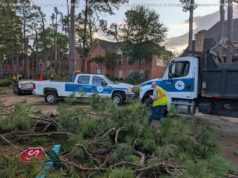Hurricane Nate pelted the central Gulf Coast with wind and rain Saturday as the fast-moving storm headed for an evening landfall somewhere along the coasts of southeastern Louisiana or…
NEW ORLEANS (AP) — Hurricane Nate pelted the central Gulf Coast with wind and rain Saturday as the fast-moving storm headed for an evening landfall somewhere along the coasts of southeastern Louisiana or Mississippi, threatening to inundate homes and businesses in vulnerable low-lying areas.
Nate was expected to pass to the east of New Orleans, sparing the city its most ferocious winds and storm surge. Cities along the Mississippi coast such as Gulfport and Biloxi were on high alert. Rain began falling on the region Saturday and forecasters called for 3 to 6 inches (7 to 15 centimeters) with as much as 10 inches (25 centimeters) in some isolated places.
Nate was a Category 1 storm with maximum winds of 90 mph (145 kph). Forecasters said it’s possible that it could strengthen to a Category 2 with winds of at least 96 mph (155 kph) before it makes landfall.
«It’s coming,» Larry Bertron said as he and his wife prepared to leave their home in the Braithwaite community of vulnerable Plaquemines Parish in southeast Louisiana. The hurricane veterans lost one home to Hurricane Katrina in 2005 and were leaving the home they rebuilt after Hurricane Isaac in 2012.
«If it floods again, this will be it. I can’t live on promises,» said Bertron, who complained that local officials haven’t done enough to improve area levees.
Governors in Louisiana, Mississippi and Alabama declared states of emergency. The three states have been mostly spared during this hectic hurricane season.
«This is the worst hurricane that has impacted Mississippi since Hurricane Katrina,» Mississippi Emergency Management Director Lee Smithson said Saturday. «Everyone needs to understand that, that this is a significantly dangerous situation.»
Louisiana Gov. John Bel Edwards urged residents to make final preparations quickly and stressed that Nate will bring the possibility of storm surge reaching up to 11 feet in some coastal areas. The storm is moving fast at 23 mph (37 kph).
«It’s going to hit and move through our area at a relatively fast rate, limiting the amount of time it’s going to drop rain,» Edwards said. «But this is a very dangerous storm nonetheless.»
Streets in low-lying areas of Louisiana were already flooded. Places outside of levee protections were under mandatory evacuation orders and shelters opened there.
Some people worried about New Orleans’ pumping system, which had problems during a heavy thunderstorm on Aug. 5. The deluge exposed system weaknesses — including the failure of some pumps and power-generating turbines — and caused homes and businesses to flood. So far, the pumping system hasn’t had any problems, the governor said.
On Alabama’s Dauphin Island, water washed over the road Saturday on the island’s low-lying west end, said Mayor Jeff Collier. The storm was projected to bring storm surges from seven to 11 feet near the Alabama-Mississippi state line. Some of the biggest impacts could be at the top of funnel-shaped Mobile Bay.
The window for preparing «is quickly closing,» Alabama Emergency Management Agency Director Brian Hastings said.
Florida Gov. Rick Scott warned residents of the Panhandle to prepare for Nate’s impact.
The governor said Saturday that residents in evacuation zones in Escambia and Santa Rosa counties should heed the warnings and seek safe shelter. He said shelters will be available to people who have nowhere else to go.
«Hurricane Nate is expected to bring life-threatening storm surges, strong winds and tornados that could reach across the Panhandle,» Scott said. The evacuations affect roughly 100,000 residents in the western Panhandle.
The Pensacola International Airport announced it will close at 6 p.m. Saturday and remain closed on Sunday. However, the Louis Armstrong New Orleans International Airport was open Saturday.
«We are urging customers to check with their specific airlines to see whether their flights have been canceled because there have been some of those,» spokeswoman Michelle Wilcut said.
At 5 p.m. EDT Saturday, Nate was located about 50 miles (80 kilometers) south of the mouth of the Mississippi River. After washing ashore, the storm is expected to weaken as it cuts through the Southeast on its way to the Northeast, which could see impacts from Nate early next week.
Nate killed at least 21 people after strafing Central America.
Waterside sections of New Orleans, outside the city’s levee system, were under an evacuation order. About 2,000 people were affected. But not everyone was complying.
Gabriel Black of New Orleans’ Venetian Isles community sent his wife, a friend and three dogs to a hotel in the city. Black stayed behind because an 81-year-old neighbor refused to leave.
«I know it sounds insane, but he has bad legs and he doesn’t have anybody who can get to him,» Black said.
Others nearby were staying as well. Nancy and Cleve Bell said their house is built so high off the ground that it stayed dry in the floods after Hurricane Katrina. Nancy Bell said they have a generator and plenty of supplies and will be safe.
___
Associated Press writer Kim Chandler in Alabama and Kevin McGill in New Orleans, and AP photographer Gerald Herbert in Plaquemines Parish, contributed to this report.
Copyright 2017 The Associated Press. All rights reserved. This material may not be published, broadcast, rewritten or redistributed.






